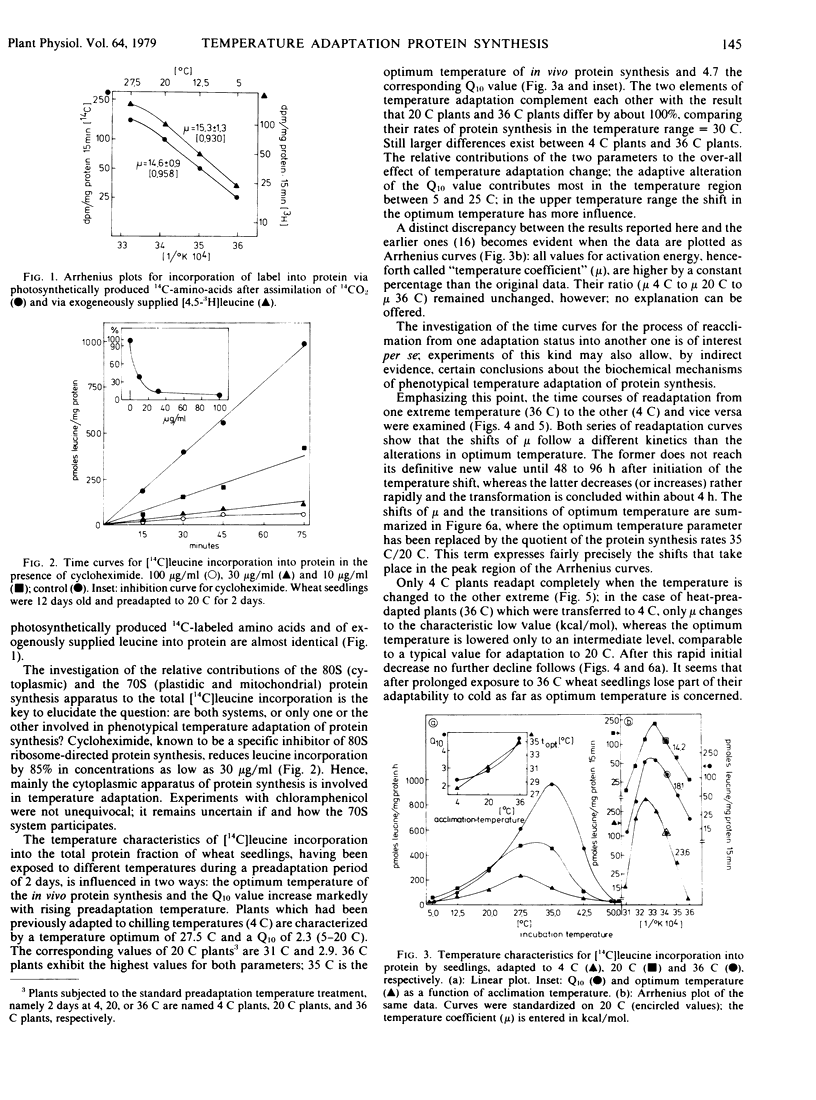Abstract
Optimum temperature and temperature coefficient of protein synthesis in young wheat plants exhibit phenotypical temperature adaptation. In plants grown for 2 days at either chilling (4 C), medium (20 C), or high (36 C) temperature the respective values are: 27 C and 14.2 kilocalories per mole, 31 C and 18.2 kilocalories per mole, 35 C and 23.6 kilocalories per mole, based on in vivo [14C]leucine incorporation into total protein. The validity of the [14C]leucine incubation method has been confirmed by double-labeling experiments. Readaptation time curves are complex: the optimum temperature parameter readjusts within approximately 4 hours to an altered temperature regime, whereas the temperature coefficient needs between 4 and 96 hours for complete readaptation—depending on the temperature conditions prior to the temperature shift. Heat-preadapted plants need a recovery period at medium temperature to regain their cold adaptability with respect to optimum temperature. Cycloheximide (30 micrograms per milliliter) reduces [14C]leucine incorporation into protein by 85%, thus indicating that predominantly the cytoplasmic 80S system of protein synthesis is involved in temperature adaptation.
Full text
PDF





Selected References
These references are in PubMed. This may not be the complete list of references from this article.
- Baldwin J., Hochachka P. W. Functional significance of isoenzymes in thermal acclimatization. Acetylcholinesterase from trout brain. Biochem J. 1970 Mar;116(5):883–887. doi: 10.1042/bj1160883. [DOI] [PMC free article] [PubMed] [Google Scholar]
- De Jong D. W., Olson A. C., Hawker K. M., Jansen E. F. Effect of cultivation temperature on peroxidase isozymes of plant cells grown in suspension. Plant Physiol. 1968 May;43(5):841–844. doi: 10.1104/pp.43.5.841. [DOI] [PMC free article] [PubMed] [Google Scholar]
- FOX A. S., BURNETT J. B. Tyrosinases of diverse thermostabilities and their interconversion in Neurospora crassa. Biochim Biophys Acta. 1962 Jul 9;61:108–120. doi: 10.1016/0926-6550(62)90037-3. [DOI] [PubMed] [Google Scholar]
- Hazel J. R., Prosser C. L. Molecular mechanisms of temperature compensation in poikilotherms. Physiol Rev. 1974 Jul;54(3):620–677. doi: 10.1152/physrev.1974.54.3.620. [DOI] [PubMed] [Google Scholar]
- Hebb C., Stephens T. C., Smith M. W. Effect of environmental temperature on the kinetic properties of goldfish brain choline acetyltransferase. Biochem J. 1972 Oct;129(5):1013–1021. doi: 10.1042/bj1291013. [DOI] [PMC free article] [PubMed] [Google Scholar]
- Hochachka P. W., Lewis J. K. Enzyme variants in thermal acclimation. Trout liver citrate synthases. J Biol Chem. 1970 Dec 25;245(24):6567–6573. [PubMed] [Google Scholar]
- McClard R. W., Kolenbrander H. M. Resolution of temperature-dependent conformers of histidine ammonia-lyase on disc gel electrophoresis: correlation with Arrhenius discontinuities. Experientia. 1974 Jul 15;30(7):730–731. doi: 10.1007/BF01924152. [DOI] [PubMed] [Google Scholar]
- Nickerson K. W. Biological functions of multistable proteins. J Theor Biol. 1973 Aug 22;40(3):507–515. doi: 10.1016/0022-5193(73)90007-6. [DOI] [PubMed] [Google Scholar]
- Pandey K. K. Isozyme specificity to temperature. Nat New Biol. 1972 Sep 6;239(88):27–29. doi: 10.1038/newbio239027a0. [DOI] [PubMed] [Google Scholar]
- Somero G. N. Pyruvate kinase variants of the Alaskan king-crab. Evidence for a temperature-dependent interconversion between two forms having distinct and adaptive kinetic properties. Biochem J. 1969 Sep;114(2):237–241. doi: 10.1042/bj1140237. [DOI] [PMC free article] [PubMed] [Google Scholar]
- Weidner M., Ziemens C. Preadaptation of protein synthesis in wheat seedlings to high temperature. Plant Physiol. 1975 Nov;56(5):590–594. doi: 10.1104/pp.56.5.590. [DOI] [PMC free article] [PubMed] [Google Scholar]


